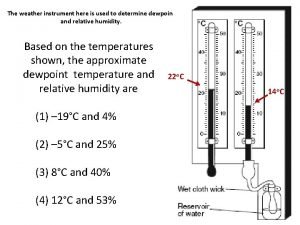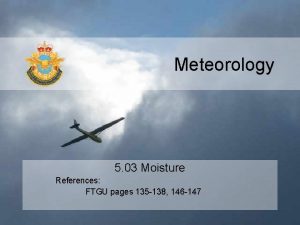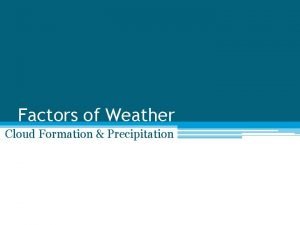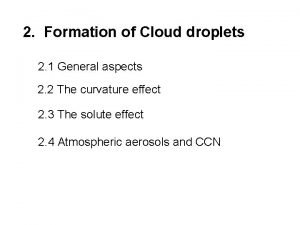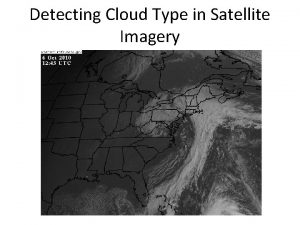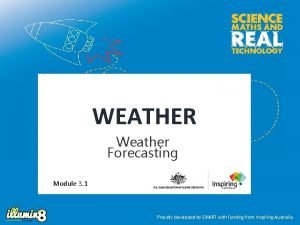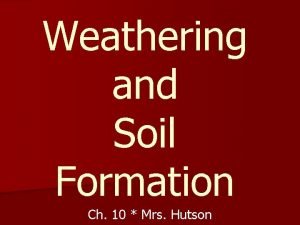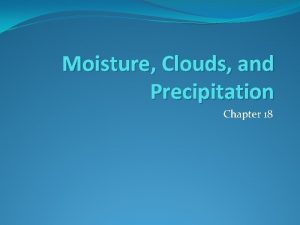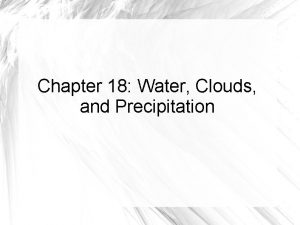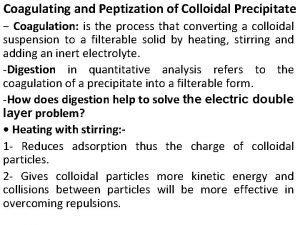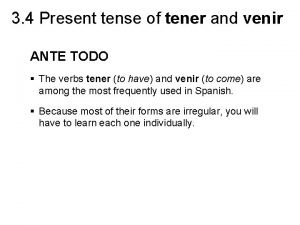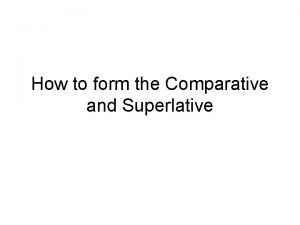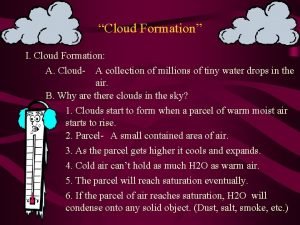Chapter 6 Cloud Development and Forms Cloud Formation
















































































































- Slides: 112

Chapter 6 – Cloud Development and Forms

Cloud Formation • Condensation (i. e. clouds, fog) results from:

Cloud Formation • Condensation (i. e. clouds, fog) results from: • Diabatic cooling (important for fog)

Cloud Formation • Condensation (i. e. clouds, fog) results from: • Diabatic cooling (important for fog) • Adiabatic cooling (important for clouds)

Cloud Formation • Condensation (i. e. clouds, fog) results from: • Diabatic cooling (important for fog) • Adiabatic cooling (important for clouds) • Clouds form due to adiabatic cooling in rising air Γd = 9. 8 o. C/km (unsaturated lapse rate) Γm ~ 5 o. C/km (saturated lapse rate)

How Does Air Rise? • 4 mechanisms cause air to rise: 1) Orographic lift – air that rises because it is going over a mountain

How Does Air Rise? • 4 mechanisms cause air to rise: 1) Orographic lift – air that rises because it is going over a mountain 2) Frontal lift – air that rises at a front

How Does Air Rise? • 4 mechanisms cause air to rise: 1) Orographic lift – air that rises because it is going over a mountain 2) Frontal lift – air that rises at a front 3) Horizontal convergence – air that is forced to rise because it is converging

How Does Air Rise? • 4 mechanisms cause air to rise: 1) Orographic lift – air that rises because it is going over a mountain 2) Frontal lift – air that rises at a front 3) Horizontal convergence – air that is forced to rise because it is converging 4) Convection – air that rises because it is less dense that its surroundings

Orographic Lift • Air rises as it approaches a mountain peak

Orographic Lift • Air rises as it approaches a mountain peak

Orographic Lift • Air descends after it goes over a mountain peak Cl ea ra ir

Rain Shadow • A rain shadow is an area of less precipitation and clouds on the downwind side of a mountain (the anti-cloud!)

Rain Shadow • A rain shadow is an area of less precipitation and clouds on the downwind side of a mountain (the anti-cloud!) • Air descends downwind of a mountain peak

Rain Shadow • A rain shadow is an area of less precipitation and clouds on the downwind side of a mountain (the anti-cloud!) • Air descends downwind of a mountain peak • Air warms adiabatically due to compression

Rain Shadow • A rain shadow is an area of less precipitation and clouds on the downwind side of a mountain (the anti-cloud!) • Air descends downwind of a mountain peak • Air warms adiabatically due to compression • Precipitation and clouds evaporate to form rain shadow

Rain Shadow

Frontal Lifting • Front – a zone of rapidly changing temperature (strong temperature gradient)

Frontal Lifting • Front – a zone of rapidly changing temperature (strong temperature gradient) Types of Fronts 1) Cold Front – cold air is advancing

Frontal Lifting • Front – a zone of rapidly changing temperature (strong temperature gradient) Types of Fronts 1) Cold Front – cold air is advancing 2) Warm Front – warm air is advancing

Frontal Lifting • Front – a zone of rapidly changing temperature (strong temperature gradient) Types of Fronts 1) Cold Front – cold air is advancing 2) Warm Front – warm air is advancing 3) Stationary Front – front isn’t moving

Frontal Lifting • Front – a zone of rapidly changing temperature (strong temperature gradient) 1) 2) 3) 4) Types of Fronts Cold Front – cold air is advancing Warm Front – warm air is advancing Stationary Front – front isn’t moving Occluded Front – you’ll find out later

Frontal Lifting Example of a cold front

Frontal Lifting Cold Front (cold air pushes warm air up) Warm Front (Warm air overruns cold air)

Convergence • Air must rise when it converges

Convergence • Air must rise when it converges

Convection • Air “bubbles” or “parcels” rise when they are warmed and become less dense than their surroundings (exactly the same way a helium balloon does) 2 km 1 km T = -8. 6 o. C T = 1. 2 o. C T = 11 o. C

Convection • Air “bubbles” or “parcels” rise when they are warmed and become less dense than their surroundings (exactly the same way a helium balloon does) 2 km • This is how thunderstorms form! 1 km T = -8. 6 o. C T = 1. 2 o. C T = 11 o. C

Atmospheric Stability • Atmospheric stability – a measure of the atmosphere’s susceptibility to vertical motion

Atmospheric Stability • Atmospheric stability – a measure of the atmosphere’s susceptibility to vertical motion • Atmospheric stability depends on the environmental lapse rate (Γe)

Atmospheric Stability • Atmospheric stability – a measure of the atmosphere’s susceptibility to vertical motion • Atmospheric stability depends on the environmental lapse rate (Γe) • Atmospheric stability comes in 3 flavors: 1) Absolutely stable

Atmospheric Stability • Atmospheric stability – a measure of the atmosphere’s susceptibility to vertical motion • Atmospheric stability depends on the environmental lapse rate (Γe) • Atmospheric stability comes in 3 flavors: 1) Absolutely stable 2) Absolutely unstable

Atmospheric Stability • Atmospheric stability – a measure of the atmosphere’s susceptibility to vertical motion • Atmospheric stability depends on the environmental lapse rate (Γe) • Atmospheric stability comes in 3 flavors: 1) Absolutely stable 2) Absolutely unstable 3) Conditionally unstable

Absolutely Unstable Air The slightest nudge sends the ball accelerating away…

Absolutely Unstable Air • Absolutely unstable: Γe > Γd (unsaturated air) Γe = 1. 5 o. C/100 m Γd = 1. 0 o. C/100 m

Absolutely Unstable Air • Absolutely unstable: Γe > Γm (saturated air) Γe = 1. 5 o. C/100 m Γm = 0. 5 o. C/100 m

Absolutely Stable Air Any push and the ball will go back to the valley and come to rest again…

Absolutely Stable Air Γd = 1. 0 o. C/100 m Γm = 0. 5 o. C/100 m Γe = 0. 2 o. C/100 m

Conditionally Unstable Air If the ball is pushed high enough, it will go over the hump and accelerate away… (otherwise it comes back to rest)

Conditionally Unstable Air Γd = 1. 0 o. C/100 m Γm = 0. 5 o. C/100 m Γe = 0. 7 o. C/100 m

Stability Summary • Absolutely unstable: Γe > both Γd and Γm

Stability Summary • Absolutely unstable: Γe > both Γd and Γm • Absoutely stable: Γe < both Γd and Γm

Stability Summary • Absolutely unstable: Γe > both Γd and Γm • Absoutely stable: Γe < both Γd and Γm • Conditionally unstable Γd > Γe > Γm

Absolutely Unstable Γd – green solid line Γm – blue dashed line Γe – black solid line

Absolutely Stable Γd – green solid line Γm – blue dashed line Γe – black solid line

Conditionally Unstable Γd – green solid line Γm – blue dashed line Γe – black solid line

What Makes the Environmental Lapse Rate (Γe)? • Γe is extremely variable in space and time (like AMA vs. MAF soundings!)

What Makes the Environmental Lapse Rate (Γe)? • Γe is extremely variable in space and time (like AMA vs. MAF soundings!) • Γe is influenced by 3 factors: 1) Near surface heating/cooling

What Makes the Environmental Lapse Rate (Γe)? • Γe is extremely variable in space and time (like AMA vs. MAF soundings!) • Γe is influenced by 3 factors: 1) Near surface heating/cooling 2) Differential temperature advection

What Makes the Environmental Lapse Rate (Γe)? • Γe is extremely variable in space and time (like AMA vs. MAF soundings!) • Γe is influenced by 3 factors: 1) Near surface heating/cooling 2) Differential temperature advection 3) Air mass replacement

Surface Heating and Cooling • Γe in the lower atmosphere changes with daytime heating and nighttime cooling

Differential Temperature Advection • Γe can change if temperature advection changes with height

Air Mass Replacement • Γe can change if an entirely new air mass moves into an area

Limitations on Convection • What stops vertical motion? - The only “stopper” is if air becomes more dense (colder) than its surroundings!!

Limitations on Convection • What stops vertical motion? - The only “stopper” is if air becomes more dense (colder) than its surroundings!! • This happens in 2 ways: 1) Stable air aloft

Limitations on Convection • What stops vertical motion? - The only “stopper” is if air becomes more dense (colder) than its surroundings!! • This happens in 2 ways: 1) Stable air aloft 2) Entrainment – intake of drier air from surroundings

Convection • Lifting condensation level (LCL) – The level at which a cloud forms (altitude of cloud base) • Level of Free Convection (LFC) – the level at which air becomes less dense (warmer) than its surroundings

Stable Air Aloft (Dry Example) Γd – green solid line Air stops accelerating Air is accelerating up Γe – black solid line

Inversions – Extremely Stable Air • Inversion – when temperature increases with height

Inversions Γd – green solid line Γm – blue dashed line Γe – black solid line

Types of Inversions 1) Radiation inversion – caused by nighttime cooling of surface air

Types of Inversions 2) Frontal inversion – occurs at fronts

Types of Inversions 3) Subsidence inversion – caused by sinking air above a static layer

Inversions and Agriculture

Entrainment • Mixing with surrounding drier, cooler air cools rising parcels through: 1) Mixing 2) Evaporation

Cloud Types Old classification of clouds 1) Cirrus (high, thin, wispy)

Cloud Types Old classification of clouds 1) Cirrus (high, thin, wispy) 2) Stratus (layered)

Cloud Types Old classification of clouds 1) Cirrus (high, thin, wispy) 2) Stratus (layered) 3) Cumulus (puffy, vertically-developed)

Cloud Types Old classification of clouds 1) 2) 3) 4) Cirrus (high, thin, wispy) Stratus (layered) Cumulus (puffy, vertically-developed) Nimbus (rain-producing)

Cloud Types New classification of clouds 1) 2) 3) 4) High clouds (higher than 19, 000 ft. ) Middle clouds (b/w 6, 000 and 19, 000 ft. ) Low clouds (below 6, 000 ft. ) Clouds with vertical development

Cloud Types

High Clouds (> 19, 000 ft. ) • Composed of ice crystals

High Clouds (> 19, 000 ft. ) • Composed of ice crystals • Principal types: 1) Cirrus

High Clouds (> 19, 000 ft. ) • Composed of ice crystals • Principal types: 1) Cirrus 2) Cirrostratus

High Clouds (> 19, 000 ft. ) • Composed of ice crystals • Principal types: 1) Cirrus 2) Cirrostratus 3) Cirrocumulus

Cirrus

Cirrostratus

Cirrocumulus

Other High Clouds - Contrails

Middle Clouds (between 6, 000 and 19, 000 ft. ) • Composed mostly of supercooled water

Middle Clouds (between 6, 000 and 19, 000 ft. ) • Composed mostly of supercooled water • Principal types: 1) Altostratus

Middle Clouds (between 6, 000 and 19, 000 ft. ) • Composed mostly of supercooled water • Principal types: 1) Altostratus 2) Altocumulus

Altostratus

Altocumulus

Low Clouds (< 6, 000 ft. ) • Composed of liquid water

Low Clouds (< 6, 000 ft. ) • Composed of liquid water • Principal types: 1) Stratus

Low Clouds (< 6, 000 ft. ) • Composed of liquid water • Principal types: 1) Stratus 2) Nimbostratus

Low Clouds (< 6, 000 ft. ) • Composed of liquid water • Principal types: 1) Stratus 2) Nimbostratus 3) Stratocumulus

Stratus

Nimbostratus

Stratocumulus

Cumulus Clouds • Cumulus clouds can extend the entire depth of the atmosphere • Principal types: 1) Cumulus - cumulus humilis (fair-weather cumulus) - cumulus congestus (fortress-like) 2) Cumulonimbus

Cumulus Humilis

Cumulus Congestus

Cumulonimbus

Other Types of Clouds • Lenticular clouds – clouds that form in wavy airstreams after air goes over a moutain

Other Types of Clouds • Banner clouds – clouds located at mountain peaks as they ascend a mountain

Other Types of Clouds • Banner clouds – clouds located at mountain peaks as they ascend a mountain • Mammatus clouds – balloon-like clouds hanging down from cumulonimbus clouds

Other Types of Clouds • Nacreous clouds – stratospheric clouds (rare!)

Other Types of Clouds • Nacreous clouds – stratospheric clouds (rare!) • Noctilucent clouds – mesospheric clouds (rare!)

Lenticular clouds

Mammatus Clouds

Banner Clouds

Nacreous Clouds

Noctilucent Clouds

Observing Clouds • Ceilometers – automated instrument that measures the height of the cloud base, or ceiling, as well as coverage

Cloud Coverage

Observing Clouds • Both cloud ceilings and coverage is reported in the standard ASOS hourly observation

Observing Clouds • Satellite imagery is also a primary tool for observing clouds and cloud motions • Visible satellite imagery • Infrared satellite imagery • Water vapor satellite imagery

Visible Satellite Imagery

Infrared Satellite Imagery

Water Vapor Satellite Imagery
 Formation initiale vs formation continue
Formation initiale vs formation continue Negative short forms
Negative short forms Strong and weak forms
Strong and weak forms Why are related forms more agreeable than unrelated forms?
Why are related forms more agreeable than unrelated forms? Why are related forms more agreeable than unrelated forms
Why are related forms more agreeable than unrelated forms Why are related forms more agreeable than unrelated forms?
Why are related forms more agreeable than unrelated forms? Steps for cloud formation
Steps for cloud formation Morning glory clouds
Morning glory clouds Cloud formation steps
Cloud formation steps What are clouds formed by
What are clouds formed by Curvature effect in cloud formation
Curvature effect in cloud formation Localized convective lifting definition
Localized convective lifting definition Curvature effect in cloud formation
Curvature effect in cloud formation Cloud type
Cloud type What does nimbo mean when added to a cloud name
What does nimbo mean when added to a cloud name How do clouds form
How do clouds form Cloud formation
Cloud formation Pixabay
Pixabay Red hat cloud forms
Red hat cloud forms Mechanical and chemical weathering venn diagram
Mechanical and chemical weathering venn diagram Emotional development in late adulthood
Emotional development in late adulthood The cloud in cloud computing refers to
The cloud in cloud computing refers to Cloud to cloud integration patterns
Cloud to cloud integration patterns Public cloud vs private cloud cost analysis
Public cloud vs private cloud cost analysis Cloud disaster recovery cloud snap
Cloud disaster recovery cloud snap 5 forms of business ownership
5 forms of business ownership Diversity and human needs and development
Diversity and human needs and development Chapter 14 the formation of western europe
Chapter 14 the formation of western europe Chapter 14 the formation of western europe
Chapter 14 the formation of western europe The formation of public opinion chapter 8
The formation of public opinion chapter 8 Love of cloud and rain chapter 18
Love of cloud and rain chapter 18 Cumulus clouds
Cumulus clouds Define community development?
Define community development? Development that ended much development crossword
Development that ended much development crossword Pattern development of a cylinder
Pattern development of a cylinder Chapter 18:1 preparing for the world of work
Chapter 18:1 preparing for the world of work Chapter 17:1 developing job-keeping skills
Chapter 17:1 developing job-keeping skills Chapter one principles of government
Chapter one principles of government Nyc doe sesis help desk
Nyc doe sesis help desk Chapter 1 section 2 forms of government
Chapter 1 section 2 forms of government Objectives of form design
Objectives of form design Child development chapter 4
Child development chapter 4 Chapter 9 agricultural transformation and rural development
Chapter 9 agricultural transformation and rural development Chapter 9 agricultural transformation and rural development
Chapter 9 agricultural transformation and rural development Chapter 9 career planning and development
Chapter 9 career planning and development Human needs and human development
Human needs and human development Chapter 8 training and developing employees
Chapter 8 training and developing employees Chapter 8 human needs and human development
Chapter 8 human needs and human development Chapter 6 learning and language development
Chapter 6 learning and language development Psychology chapter 6 learning
Psychology chapter 6 learning Chapter 7 training and development
Chapter 7 training and development Development of ihrm
Development of ihrm Chapter 34 reproduction and development answer key
Chapter 34 reproduction and development answer key Infancy psychosocial development
Infancy psychosocial development Chapter 35 plant structure growth and development
Chapter 35 plant structure growth and development Chapter 9 career planning and development
Chapter 9 career planning and development Chapter 9 career planning and development
Chapter 9 career planning and development Chapter 5 cognitive development in infancy and toddlerhood
Chapter 5 cognitive development in infancy and toddlerhood Vascular ray
Vascular ray Word formation prefixes and suffixes examples
Word formation prefixes and suffixes examples Mechanical entrapment in gravimetric analysis
Mechanical entrapment in gravimetric analysis Complex ion formation and solubility
Complex ion formation and solubility Animal
Animal Difference between occlusion and mixed-crystal formation
Difference between occlusion and mixed-crystal formation Geometric and photometric image formation
Geometric and photometric image formation Stamen definition
Stamen definition Reticular formation and sleep
Reticular formation and sleep Multiple processes words examples
Multiple processes words examples Difference between colloidal and crystalline precipitate
Difference between colloidal and crystalline precipitate Partnership formation and operation
Partnership formation and operation Alphabet test and word formation
Alphabet test and word formation Partnership formation and operation
Partnership formation and operation Ease and cost of formation
Ease and cost of formation Partnership formation and operation
Partnership formation and operation Light and the formation of shadows
Light and the formation of shadows Petroleum and natural gas formation
Petroleum and natural gas formation Partnership formation and operation
Partnership formation and operation Strong and weak forms exercises
Strong and weak forms exercises Examples of dirge poems
Examples of dirge poems Onomatopoeia and alliteration are classified as
Onomatopoeia and alliteration are classified as Infinitive passive voice
Infinitive passive voice Saber and conocer difference
Saber and conocer difference Simple past and past progressive
Simple past and past progressive Nourishing element of stock
Nourishing element of stock Simple and progressive forms
Simple and progressive forms Progressive verb forms
Progressive verb forms What have you learned about modifiers of human act?
What have you learned about modifiers of human act? Which of the market form of meat does not undergo chilling
Which of the market form of meat does not undergo chilling Secondary retention features
Secondary retention features F&p accuracy chart
F&p accuracy chart Market forms of shellfish with pictures
Market forms of shellfish with pictures Tented arch fingerprint
Tented arch fingerprint What are the many forms of energy
What are the many forms of energy Polar and rectangular forms of equations
Polar and rectangular forms of equations Venir and tener
Venir and tener Did question form
Did question form Big idea of energy
Big idea of energy The limited access zone of a masonry wall must be
The limited access zone of a masonry wall must be Mcas alt portfolio
Mcas alt portfolio Secondary reinforcer
Secondary reinforcer 100 examples of energy transformation
100 examples of energy transformation Kind of water forms
Kind of water forms Masonry saw shall be guarded with a
Masonry saw shall be guarded with a Circus possessive form
Circus possessive form Calm superlative
Calm superlative Comparative of miserable
Comparative of miserable Contrived experiences means
Contrived experiences means Engineering notation is in steps of what
Engineering notation is in steps of what Schema refinement and normal forms
Schema refinement and normal forms What did the decimal say to the other
What did the decimal say to the other Schema refinement and normal forms
Schema refinement and normal forms Serious superlative and comparative
Serious superlative and comparative Gerund uses
Gerund uses






